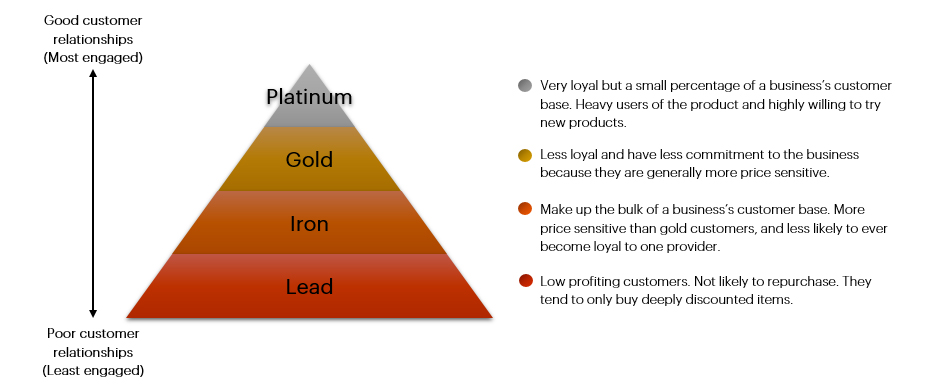Retaining customers in-between purchases is all about warming them up for their next purchase and keeping your brand top of mind. Here, we explore all things customer engagement and interactions.
Effective customer retention comes back to developing cost effective links with customers because it’s a win-win for both parties. To do so, you need to provide value when engaging with people. If we look at a standard marketing model, we see different levels of customers and the need to guide and convert them through with ease.
Ideally, it should look something like this:

Be honest: how engaged are your customers with your brand and its products?
If you’ve got high customer retention levels, that’s a sign you’re delivering value that can’t be found elsewhere. Congratulations! You’ve got plenty of satisfied customers! From there, you can really work on achieving higher customer lifetime value averages.
Let’s tackle part two of the customer engagement and retention metrics online that retailers should be tracking!
New visitors vs. returning visitors
When drawing on sales KPIs, we talked about returning customers vs. new customers and especially, how to get new customers to stay with your brand while doing the same for returning customers. Sure, looking at this metric as a standalone won’t reveal much but it can help ecommerce retailers to gauge the success (or lack of) of their digital marketing campaigns. If you think about retargeted ads for example, your data for returning visitors should be higher. If they’re not, something isn’t quite right.
New visitors vs. returning customers helps you to determine what campaigns appeal to new and returning customers. It also highlights what campaigns entice both audiences to return to your website. A/B testing via marketing campaigns can be really useful here. You can also look at your newsletter interactions and see pretty quickly whether your customers are engaged or not.
What you really want to be doing is providing users with helpful information on your blog and landing pages. Cover topics such as how to use certain products and getting the most out of items. Remarketing ads are a great tool for reminding past visitors of your brand and offers.
Customer retention Rate
Customer retention refers to a business’ ability to keep a paying customer over a set period of time. Acquiring new customers is expensive, costing a business 5 to 25 times more than it takes to retain a customer.
You might attract a lot of visitors to your website and convert them into paying customers but here’s the bigger question: can you hold onto them over a longer period of time?
According to RJmetrics, the most successful ecommerce businesses get more than half of their revenue from repeat customers. You want to keep a close eye on your business’ customer retention rates. Why? Because they show what percentage of your customers have stayed with your brand over a given period of time. It can be calculated on an annual, monthly or weekly basis. Jeff Haden, Contributing Editor at Inc., outlines an accurate way of measuring this metric:
Customer Retention Rate = ((CE (Number of customers at end of period) – CN (Number of new customers acquired during period)) / CS (Number of customers at start of period)) x 100
First response time
Speed and customer satisfaction go hand-in-hand. Consumers expect a seamless shopping experience and if they don’t get one, they vote with their feet (or hands)!
As expected, many companies and studies have found a correlation between customer satisfaction and timeliness and speed, especially first response times. 50% of customers will wait one week for a customer service representative response before they stop doing business with that brand.
You need to respond to customer requests quickly and it’s not as hard as you may think thanks to automated messages that communicate ‘someone’ on your team is looking after the issue at hand. Technically, this isn’t an actual first response but it’s a handy way to comfort customers and reassure them that their request is being looked after.
What makes this scenario even trickier is that customer expectations regarding response times often differ depending on the contact channel at play. 32% of social media users who contact a brand expect a response within 30 minutes and 42% expect a response within 60 minutes.
However, speed isn’t always the most important factor in terms of customer support. One study, conducted by Genesys, asked more than 9,000 consumers what mattered to them most when it came to interacting with companies - 40% of them said better human service. In other words, a customer service member’s empathy, engagement and willingness to help. This more than doubled the responses that the second place answer received.
Newsletter subscribers
We talk a lot about what a powerful tool email marketing is… that’s because it is! Why? It provides more value to your customers after they make a purchase and assists them in using and caring for products better. The more engaged subscribers you have on your list, the better - viewing how many people are opting in/out of your newsletter is simple. It’s also important to look at other data such as the demographics of your newsletter subscribers to make sure you’re reaching your target audience.
It is time to reassess your newsletter strategy if you’re:
- Concerned your blogs sent out in EDMs aren’t being read because they’re not resonating with people
- Steadily losing subscribers over time
In this case, go back to the basics. Review what’s been done, what worked in the past, what hasn’t and never be afraid to try and test news things. Details matter: even something as seemingly meaningless as send times and using engaging/punchy email subject lines can really make a difference.
Subscriber growth rate
You have subscribers… that’s great! How quickly is your list growing? Pairing this KPI with the total number of subscribers gives you a great insight as to how email marketing is performing for you brand and how to improve that performance.
Email open rate and email click-through rate (CTR)
Even though you may have a healthy amount of subscribers, consider if they are actually opening your emails and then clicking through to read website content. If you have a low email open rate, you could test new subject lines or try cleaning your list for inactive or irrelevant subscribers. Open rates will tell you the percentage of subscribers opening emails but CTR communicates how many people click on any links after they open it. Potentially, the latter is the more important metric as without clicks, you won’t drive any traffic to your site.
When was the last time you checked your social media measures? Likes, followers, your channels’ growth and how each compares to your competitors. Track and measure everything!
Customer satisfaction (CSAT) and lifetime metrics
“How satisfied were you with your experience?”
We’re sure you’ve seen this survey question on sites many times. It’s usually answered using a numbered scale and provides real insight as to how satisfied people interacting with your brand actually are.
Word of mouth
As many businesses learn quickly, word of mouth is an extremely important factor. Stats out there indicate that with a bad experience, a customer tells 10+ people while a good experience will only likely see them telling 1 or 2 people. Plus, 74% of consumers identify word of mouth as a key influencer in their purchasing decisions. Word of mouth can be harsh but you can’t deny its power with consumers.
Net promoter score (NPS)
Your NPS provides your business with insight into customer relationships and loyalty by telling you how likely customers are to recommend your brand to someone in their network.
According to Net Promoter Network, there are three levels of customer advocacy:
- Promoters (score 9-10): loyal customers who praise your company and drive sales
- Passives (score 7-8): those satisfied but unenthusiastic customers who are happy to leave when they see a better offer
- Detractors (score 0-6): unhappy customers who spread negative information about your company and can damage your brand image.
Number and quality of product reviews
Product reviews are great for a number of reasons as they:
- Provide social proof
- Can help with SEO
- Give you valuable feedback for your business
Both the quantity and quality of product reviews are important KPIs to track for any ecommerce business. Keep in mind, these are what potential customers will consider when deciding whether to interact with your brand - it’s very important to be aware about what’s being said and has been made public about your business. Read the reviews and reach out to people who are not satisfied with their experience to find out why. Almost every brand has had a bad experience with negative comments so have a process in place and implement it accordingly.
Key tips to retaining customers
To recap, our braintrust have put together the following checklist to help your business retain as many customers as possible. Here we go:
#1. Provide seamless and engaging user experience
#2. Respond to customer queries in less than 24 hours
#3. Give people value via loyalty programs, special rewards/sales or product packages
#4. Effectively manage your brand’s word of mouth and pay attention to customer reviews
Need one-on-one help with retaining customers and engagement? Contact Woven today and our team of experts will be in touch.

